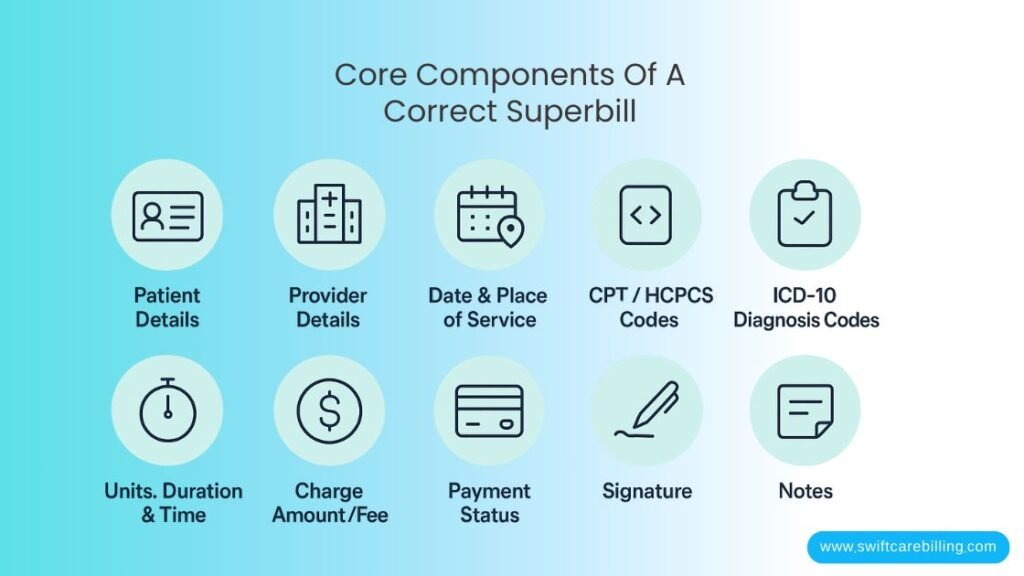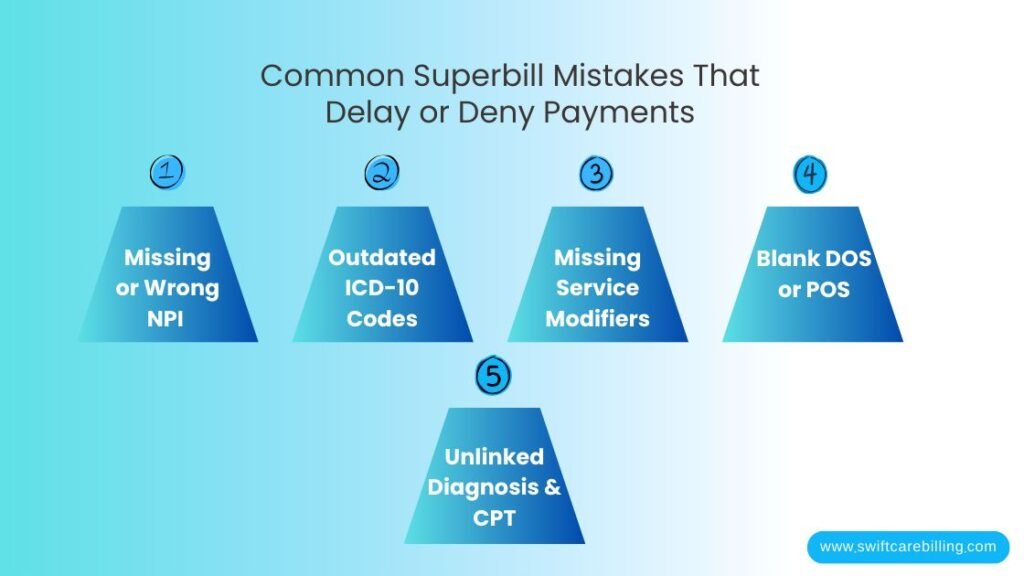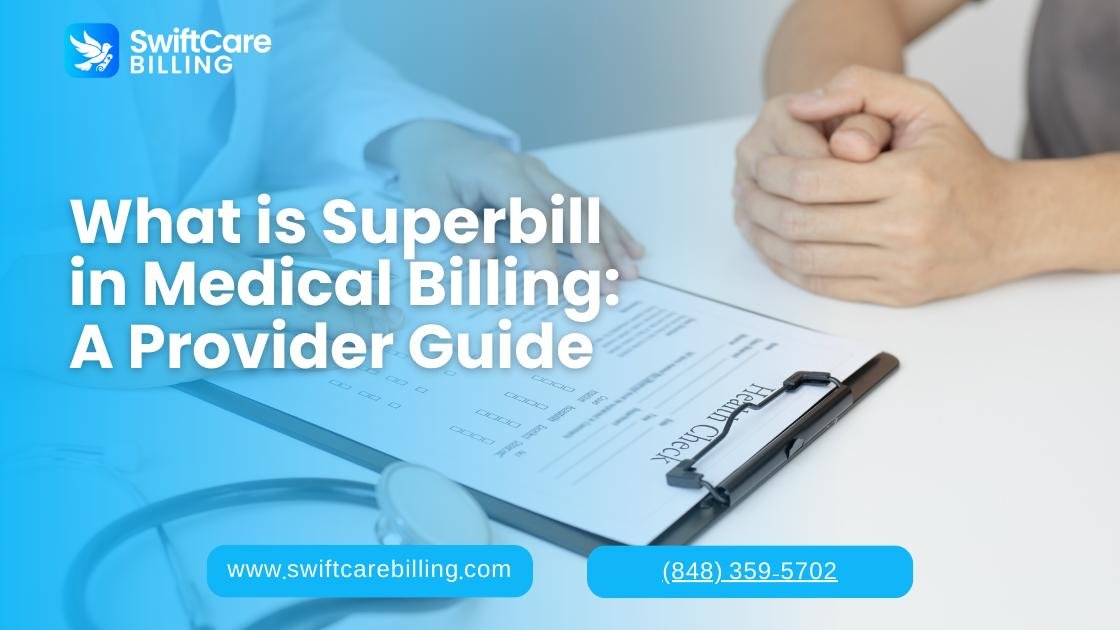In medical billing, a superbill keeps reimbursement moving.
It’s a single, itemized sheet that tells insurers exactly what happened during a patient visit — from diagnoses and procedures to fees and provider identifiers.
Whether you’re a solo therapist helping clients get out-of-network reimbursement or a multi-provider clinic feeding data to a billing team, the superbill is your proof of care and payment blueprint.
Get it right, and claims move fast. Get it wrong, and you invite denials, delays, and frustrated patients.
This guide breaks down everything you need to know — from core components to common mistakes — so you can make superbills bulletproof.
What is a Superbill in Medical Billing?
A superbill is a detailed, itemized record of a patient encounter used to file insurance claims or let patients request reimbursement, especially for out-of-network care.
It lists diagnoses, procedures, fees, and necessary identifiers so a payer can process reimbursement or so a biller can build a claim.
It contains patient and provider info, CPT/HCPCS codes, ICD-10 codes, dates, fees, and payer notes.
It is the “data passport” that a claim needs to travel from your office to the payer.
Below is a concise superbill template you can paste into Word or your EHR:
· Provider: Evergreen Clinic, 123 Main St, City, ST — NPI: 1234567890 | Taxonomy: 208D00000X
· Patient: John | DOB: 1980-03-05 | Policy #: ABC123456 | Phone: (555) 555-5555
Date of Service: 2025-08-01 | POS: 11
| Line | CPT/HCPCS | Modifier | Units | ICD-10 | Dx Link (1/2/3) | Fee | Notes |
| 1 | 99213 | 1 | R51 | 1 | $125 | Established office visit, problem-focused | |
| 2 | 93000 | 1 | I10 | 2 | $30 | ECG, 12 leads | |
| 3 | 81002 | 1 | N39.0 | 3 | $10 | Urinalysis, non-micro |
Total Charge: $165
Payment Received: $25 (copay) — Balance Due: $140
Provider Signature: __________________
(For therapy/time-based codes, add session length and start/end times beside CPT.)
NOTE: Paste an image/PDF of the updated superbill template here for an authentic source
Why this matters (and who needs it)
For solo providers and small practices:
If you don’t bill insurance directly — which is common for therapists, nutritionists, and other independent clinicians — the superbill is your patient’s golden ticket to getting money back from their insurance. Without it, they can’t even start the reimbursement process.
For larger practices and billing teams:
In bigger operations, the superbill is the master data sheet that billers use to create and submit insurance claims. If it’s incomplete or wrong, the error ripples through the whole billing chain — meaning delayed payments and extra admin headaches.
For certain types of visits:
Superbills aren’t just for in-person appointments. They’re crucial for:
- Out-of-network care — so patients can submit claims themselves.
- Telehealth sessions — where insurers may request proof of service details.
- Therapy and counseling — where time-based CPT codes need clear documentation.
- Specialty consultations — like dermatology, podiatry, or cardiology, especially if they’re out-of-network.
Remember, if the visit isn’t being billed directly to insurance through your practice’s system, the superbill is the only bridge between the care provided and the reimbursement owed.
Core Components Of A Correct Superbill

A superbill is your all-in-one “proof of visit” sheet. If even one key field is missing, you risk delayed claims, denials, or endless back-and-forth with the payer.
Here’s a superbill must-have:
Patient details
Full legal name, date of birth, address, and insurance or policy number (if available). This ensures the payer can match the service to the right member without guesswork. (supanote.ai)
Provider details
Your practice name, address, phone number, NPI (National Provider Identifier), taxonomy code, and license number (if required by the insurer). This is how the payer knows exactly who rendered the service.
Date and place of service
Always record the exact date of service and the correct POS code (e.g., 11 for office, 02 for telehealth). Missing or wrong POS can cause automatic rejections. (CareCloud)
CPT / HCPCS codes
List the correct procedure or service codes for everything done — with modifiers when needed. These tell the payer what you did.
ICD-10 diagnosis codes
Pair each CPT with the most specific ICD-10 diagnosis possible. Avoid vague codes unless there’s no more precise option — payers love specificity.
Units, duration, and face-to-face time
If you’re billing for time-based services (like psychotherapy or prolonged services), include exact minutes and the number of units billed.
Charge amount/fee
Put the price for each line item and a total at the bottom. Even if the insurer has a contracted rate, your Charge sets the starting point.
Payment status
Show what the patient paid during the visit (e.g., copay) and what’s still outstanding.
Signature
Some insurers want a signed superbill or provider attestation — especially for audits.
Notes
Add any extra info that supports medical necessity or meets payer quirks (e.g., referring provider name, authorization number, or special instructions).
Superbill → Claim: How The Data Flows (Workflow)
1. Clinician finishes visit and documents medically.
2. The clinician or front desk generates a superbill (paper or EHR). Many EHRs build superbills automatically after charting. DrChronoDrChrono Support
3. If you bill in-house, the biller imports superbill data into the practice management system, maps ICD/CPT/modifiers, builds and scrubs the claim, and then transmits (837 electronic claim). AAPC
4. If the patient files, provide the patient with a clean superbill and clear filing instructions and address for their insurer (often needed for out-of-network reimbursement). Sprypt
Electronic superbills vs. paper superbills
Electronic Superbills
These are created inside an EHR (Electronic Health Record) or PM (Practice Management) system. The big advantages?
- Fewer errors — codes and patient info pull directly from the chart, so no messy handwriting or typos.
- Faster submissions — many systems let you push the superbill straight into the claims module.
- Extra documentation — you can attach progress notes, lab results, or prior authorizations in one digital packet.
Popular platforms like DrChrono, Kareo, and others have built-in superbill features that let providers select codes on the spot and hand patients a clean, claim-ready form. (DrChronoYouTube)
Paper Superbills
Yes, they’re still alive and well — especially in small practices, private therapy offices, and out-of-network care. Paper superbills can be quick and low-tech, but they come with caveats:
- Must be legible and complete — a missed field means a claim delay.
- Require manual data entry into the billing software or claim form.
- It can be misplaced or damaged before submission.
Electronic vs. Paper Superbills: A Comparison Table
| Feature / Factor | Electronic Superbills | Paper Superbills |
| How they’re created | Generated inside an EHR or Practice Management system. | Filled out by hand or printed from a pre-made template. |
| Error risk | Low — pulls patient/provider data directly from the system, reducing typos and missing fields. | Higher — handwriting errors, missing info, and illegible entries are common. |
| Speed | Fast — can be submitted instantly to the billing module or exported for patients. | Slower — requires manual data entry into claim forms or billing software. |
| Supporting documentation | Can attach notes, lab results, or prior authorizations digitally. | Must provide separate physical documents; easier to misplace. |
| Cost | Requires EHR/PM subscription or software access. | Low-cost or free —need printed forms. |
| Security | HIPAA-compliant digital storage and encryption. | Must be stored physically and secured to prevent unauthorized access. |
| Best for | Medium to large practices, tech-savvy small practices, and providers who bill frequently. | Solo practitioners, therapists, and out-of-network providers without EHR access. |
| Examples | DrChrono, Kareo, AdvancedMD. | Custom clinic forms, downloadable superbill templates. |
If you have an EHR, go electronic — it saves time and headaches. If you’re on paper, use a clean, pre-formatted template and train staff to double-check every field before handing it to the patient or biller.
A Superbill Checklist Before You Send to a Patient or Biller
Make sure every superbill you issue is complete and accurate:
- Patient name and date of birth are correct.
- NPI and provider address are included.
- Date of service and place of service (POS) are filled in.
- CPT codes are listed and correctly linked to ICD-10 codes, with modifiers if needed.
- Units and time are recorded for any time-based services.
- Fee amounts and payment status are clearly stated.
- Provider signature or attestation is included if the payer requires it.
Out-of-Network Patients — What to Tell Them
In case of out-of-network patients:
· File quickly — don’t miss the timely-filing window: Most insurers give 90–180 days to file after the date of service. If your patient misses that, their chance of reimbursement drops to zero. Tell them to send it in ASAP.
· Include proof of payment and an itemized statement: The superbill alone isn’t enough — insurers need to see the patient’s actual payment. A copy of the receipt plus an itemized statement with CPT/ICD-10 codes strengthens their claim.
· Follow the payer’s exact instructions: Every insurer has its quirks — some want the provider to submit, others require the patient to fill out a specific claim form. Point them to the insurer’s “Member Reimbursement” section online or the number on their card.
· Offer to guide them through the claim form: Patients often get overwhelmed by the forms. Spending five extra minutes walking them through it not only increases the odds they get paid, it makes them remember your office as helpful and patient-friendly — which means better word-of-mouth.
Common Mistakes to Avoid (and why they matter)

Missing NPI or wrong NPI on the superbill
Your National Provider Identifier (NPI) is the universal ID that payers use to identify you. If it’s missing or incorrect, the claim will almost always get rejected. Think of it like mailing a letter without the correct return address — it might get lost in the system.
Using outdated ICD-10 code versions
ICD-10 codes get updated every October. Using old codes is like speaking a language the payer no longer understands. Even if the service was medically necessary, outdated codes can cause denials or require re-filing. Keep your EHR or code list refreshed annually.
Failing to include modifiers for distinct services
Modifiers (like -25 or –59) tell the insurer you performed separate, billable services on the same day. Without them, the payer may “bundle” your charges and pay you less — or deny the extra service entirely.
Leaving the date of service or POS blank
The Date of Service (DOS) shows when the care happened, and the Place of Service (POS) code indicates the location of service (office, telehealth, hospital, etc.). Missing either is like handing in homework with no name or date — no one knows where to file it.
Not linking the diagnosis to the CPT in the patient’s chart
Every CPT code should be connected to an ICD-10 code that justifies why the service was done. If they’re not linked, the payer sees it as an unsupported charge — and your payment gets stalled.
Best Practices to reduce denials and speed reimbursement
If you want your claims to sail through without getting stuck in denial limbo, every detail on your superbill matters. A few habits can make the difference between fast payment and weeks of delay.
· Code accurately and specifically. Use the most precise ICD-10 code available to support medical necessity.
· Include modifiers correctly, such as -25 or 59. The wrong modifier can lead to a denial.
· Match each diagnosis code to its corresponding CPT. If they don’t logically align, expect the claim to be flagged.
· Use an EHR-generated superbill when possible. Automated code suggestions and linking reduce human error.
· Train front desk staff to capture correct insurance and demographic details at check-in. Minor errors can cause rejections.
· Keep a quick-reference list of common codes for your specialty to speed entry and avoid mistakes—example: therapists — 90791, 90834, 90837.
· Timestamp all time-based services. Many payers require exact minutes for psychotherapy or prolonged care.
Conclusion
A superbill isn’t just paperwork — it’s the bridge between your care and your payment. Every field, every code, every date matters. When you handle them with precision, patients get reimbursed faster, claims sail through without denials, and your practice runs smoother.
At Swiftcare Billing, we take the headache out of medical billing. From generating clean, compliant superbills to scrubbing claims for accuracy, we make sure you get paid without the back-and-forth. Our team knows payer quirks, coding updates, and the little details that keep reimbursements flowing.
Talk to Swiftcare today — and turn your superbills into stress-free, on-time payments.
FAQs
Can patients submit a superbill to insurance for reimbursement?
Yes. Patients can submit a provider’s superbill along with proof of payment to request reimbursement for out-of-network services. Each insurer has its own process and filing deadlines, so patients need to follow their plan’s instructions. (Sprypt)
Is a superbill the same as a claim?
No. A superbill is a detailed source document. A biller or insurer uses it to create a claim (such as an 837 electronic file) for submission.
Do EHRs generate superbills automatically?
Many modern EHR and practice management systems can generate a superbill right after clinical charting. This feature reduces errors and speeds up the billing process. Examples include DrChrono, Kareo, and others.
What if my superbill gets denied?
Start by checking for coding mismatches, missing modifiers, incorrect patient demographics, or a wrong/missing NPI. Correct the errors and resubmit promptly. Use a denial tracking log to identify and prevent recurring problems.
Can I use the same superbill for telehealth visits?
Yes, make sure you use the correct place-of-service (POS) code for telehealth and include any payer-specific modifiers, like 95 or GT, if required.



